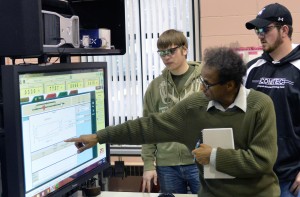 With the help of a 125-year-old Winona-based business, students in the Winona State University Composite Materials Engineering program are getting valuable hands-on experience as they prepare to enter the industry.
With the help of a 125-year-old Winona-based business, students in the Winona State University Composite Materials Engineering program are getting valuable hands-on experience as they prepare to enter the industry.
In 2014 WSU was awarded a new piece of equipment, a biaxial strain gage extensometer, through the Leveraged Equipment Program. The program is a partnership between the state and employers to fund equipment for academic instruction in areas of high employer need. In WSU’s case, Winona’s own RTP Company provided the match to acquire the extensometer.
Karl Hoppe, a composite material engineer with RTP and a 1998 WSU alumnus, said the equipment provides valuable data for his company as well as critical experience for the students.
“We had a need for the extensometer because it allows us to provide excellent data for our customers to design parts,” Hoppe said. “It also gives students exposure to these companies through interaction and report writing, and helps them understand how the tests and data are used when designing parts.”
The extensometer provides measurements, ratios and graphs of a composite material as it is stretched, flexed or compressed to the breaking point. A standard extensometer tells only how much the length has changed in one direction, but a biaxial extensometer evaluates changes in length and width.
Beckry Abdel-Magid, professor in the Department of Composite Materials Engineering, said the measurements provided are extremely useful for designing composite materials.
“When we make these composite materials, we want to know how strong they are, how stiff they are and how flexible they are,” Abdel-Magid said. “When you stretch a material one direction, it will shrink in another. By measuring how much deformation can happen in both directions, we can design materials to withstand various forces and stresses, and obtain, for example, zero change in dimensions in high-precision applications.”
Some of these high-precision applications include satellites and space telescopes. In space, extreme temperature changes can cause stretching and shrinking, and knowing the limits of composite materials can mean the difference between a clear image and a fuzzy image.
Beyond the critical data and tremendous gains in student experience, the extensometer also helps expand the services of COMTEC. COMTEC is an industry-university partnership that has undertaken hundreds of projects for the composite materials industry on local, regional and national levels. It employs students who work under the supervision of director Matthew Benson.
The extensometer also helps WSU’s composite materials students tremendously when it comes to building the skills they need to be successful in the composites industry.
“It’s not so much experience with the machine is so valuable, but experience with the data it provides that is critical,” Hoppe said. “They will have to work with the data they are testing, and in a company like RTP, understanding how the data is used is incredibly valuable, as well as knowing the good, the bad and the pitfalls of the data.”
The extensometer resides in the middle of a large warehouse-like room in WSU’s Stark Hall. Various materials of all types and sizes wait in queue around the room to be broken for the benefit of science and engineering.
“We’re really happy with it,” said Abdel-Magid. “Our students are seeing the benefits of quick and precise measurements of essential properties of composites.”
For more information, call the WSU Communications Office at 507-457-5024.

I am looking at training a portion of our employees in carbon fiber part manufacturing. We are an aerospace manufacturing and modification company in the Twin Cities. To date most of our product manufacturing has been using metals. We are working on introducing some carbon fiber products in the upcoming year.
I am wondering if WSU has a 40-80 hour short course on manufacturing parts utilizing prepreg carbon fiber and foam core. The focus would be to have both class and hands-on training. We have sent a few individuals to initial training with ABARIS in Reno, NV. Training a larger group is more challenging and using a local alternative would be better.
If WSU does not have such of a short course, would there be an opportunity to develop a training course to meet our needs? We have meet with MnDEED and understand there are opportunities for grant funding for training if done through an accredited MN facility. Potentially something could be coordinated with Inver Grove Heights Community College or the St. Paul Vo-Tech.
I would be more than happy to drive down to Winona discuss this further. Thank you and I look forward to hearing from WSU.
Brad Bystrom
612-865-8069.
BBystrom@Wipaire.com